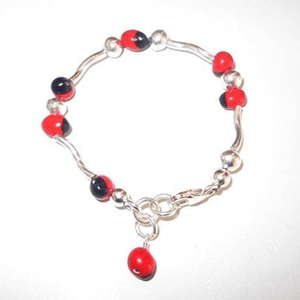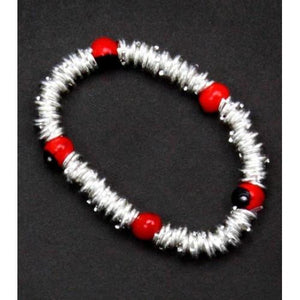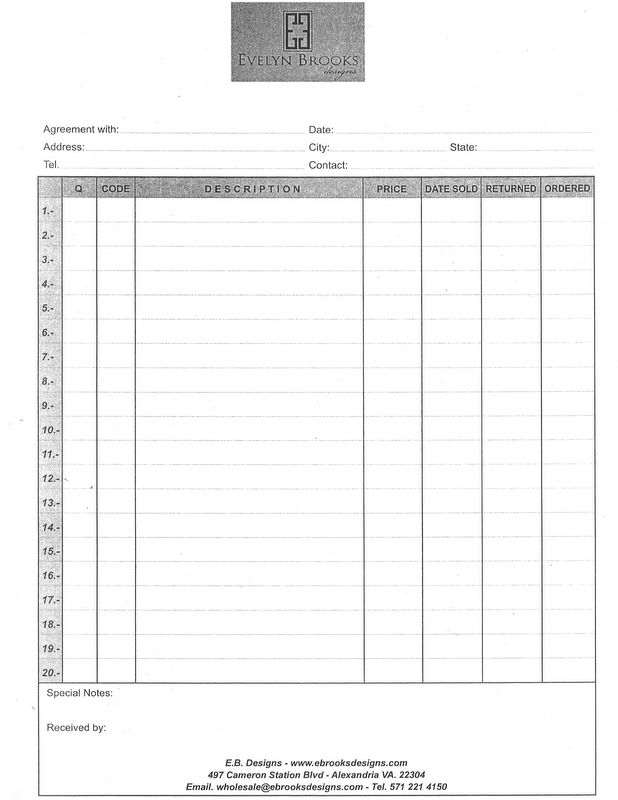Latest News Latest News
Jewelry on Consignment a Nightmare Jewelry on Consignment a Nightmare
Evelyn Brooks Designs has been in business for almost nine years.
Upcoming jewelry designers must ask themselves just as I did once, “How can I see my jewelry in boutiques and galleries? What can I do to make that happen? How do I find the best place for myself? How do I know my work will be accepted?”
Allow me to share with you my story as a jewelry designer and how jewelry on consignment is a great boost for your new business, despite its sometimes nightmarish repercussions.
My work was initially accepted at different boutiques and galleries right off the bat, “on consignment.” This basically means that after bringing your jewelry, say 20-30 pieces, to a gallery or boutique, they will add your line to their inventory, selling it on your behalf while paying you a percentage of the earnings.
Some galleries and boutiques may agree to pay you half at 50/50, while others arrange for a 60/40 or 70/30 payout. For example, a jewelry piece with the value of $100 under a 70/30 agreement will grant $70 or $30 to each party. Likewise, a 60/40 agreement owes $60 or $40 respectfully, either to you or the consignment shop. It is usually customary to receive payment 30 days after your piece is sold or to get paid within the first 7 days of the following month.
Luckily, I have been able to work with pretty good galleries and boutiques that have their consignment payment dates kept fairly consistent, allowing me to mark those dates down on my calendar and stay organized.
Among the galleries and boutiques I have worked with, some of my favorites are:
Due to ethical reasons, I’m reluctant to state by name the specific galleries I suggest that a designer avoids. Alternatively, I intend to provide some guidance to those new to the business by sharing some unfortunate experiences I’ve had throughout my career, some of which felt like an absolute nightmare.
As a jewelry designer, rule number one is having a consignment agreement in place, and if you haven’t completed this step yet, I urge that you begin by researching what to include in the terms.
Things you may consider…
- Time of your consignment (Do you want your pieces in store for thirty, sixty or ninety days? Or perhaps six months?)
- Form of payment and dates of payment
- Commitment and caring instructions for your jewelry
- Accounting method for your jewelry (my jewelry pieces have a code necessary for accounting purposes that shows what sells in my inventory)
Evelyn Brooks Designs is based in Virginia and I remember a gallery I wanted to work with so badly in NYC! Well, from the moment they saw my consignment agreement, they refused to commit due to my accounting and caring instructions. So even if I wanted to be in this gallery, I followed my instinct which told me: (this is not right for you Evelyn…) I’ve found that it’s been most helpful to simply trust your senses, assess the pros and cons and carefully think it over before making a final decision.
 I’m very upset about the way certain places are continuing to operate their consignment agreements with artists, and the disrespect shown towards the work of rising designers. I’ve always understood how artists begin their careers by having their work displayed on consignment, because it’s important for the gallery to know if your work sells. However, not returning your phone calls, not paying you on time and making you drive to their location to see if your work is selling or not is absolutely ridiculous and a complete waste of time and money. And it won’t be the only place you work with like that…so is it really worth the trouble to work on consignment in the end?
I’m very upset about the way certain places are continuing to operate their consignment agreements with artists, and the disrespect shown towards the work of rising designers. I’ve always understood how artists begin their careers by having their work displayed on consignment, because it’s important for the gallery to know if your work sells. However, not returning your phone calls, not paying you on time and making you drive to their location to see if your work is selling or not is absolutely ridiculous and a complete waste of time and money. And it won’t be the only place you work with like that…so is it really worth the trouble to work on consignment in the end?
After so many years in business, Evelyn Brooks Designs offers 10% of its business on consignment. The remainder of its profits are the result of direct purchase orders from retail galleries, boutiques we meet at different wholesale shows, government and corporate contracts and direct sales to clients via retail events, online and catalog sales.
That being said, I caution to all rising and upcoming jewelry designers that the benefits of offering your business on consignment are only helpful in the short run. True, it’s immensily helpful for starting and expanding your business presence in the beginning, but continuing down the consignment path forever will only lead to a nightmare no one deserves to have as a jewelry designer.
I truly hope this kind of information helps you and brings value to your career;)
Sincerely,
Evelyn Brooks
Evelyn Brooks Designs has been in business for almost nine years.
Upcoming jewelry designers must ask themselves just as I did once, “How can I see my jewelry in boutiques and galleries? What can I do to make that happen? How do I find the best place for myself? How do I know my work will be accepted?”
Allow me to share with you my story as a jewelry designer and how jewelry on consignment is a great boost for your new business, despite its sometimes nightmarish repercussions.
My work was initially accepted at different boutiques and galleries right off the bat, “on consignment.” This basically means that after bringing your jewelry, say 20-30 pieces, to a gallery or boutique, they will add your line to their inventory, selling it on your behalf while paying you a percentage of the earnings.
Some galleries and boutiques may agree to pay you half at 50/50, while others arrange for a 60/40 or 70/30 payout. For example, a jewelry piece with the value of $100 under a 70/30 agreement will grant $70 or $30 to each party. Likewise, a 60/40 agreement owes $60 or $40 respectfully, either to you or the consignment shop. It is usually customary to receive payment 30 days after your piece is sold or to get paid within the first 7 days of the following month.
Luckily, I have been able to work with pretty good galleries and boutiques that have their consignment payment dates kept fairly consistent, allowing me to mark those dates down on my calendar and stay organized.
Among the galleries and boutiques I have worked with, some of my favorites are:
Due to ethical reasons, I’m reluctant to state by name the specific galleries I suggest that a designer avoids. Alternatively, I intend to provide some guidance to those new to the business by sharing some unfortunate experiences I’ve had throughout my career, some of which felt like an absolute nightmare.
As a jewelry designer, rule number one is having a consignment agreement in place, and if you haven’t completed this step yet, I urge that you begin by researching what to include in the terms.
Things you may consider…
- Time of your consignment (Do you want your pieces in store for thirty, sixty or ninety days? Or perhaps six months?)
- Form of payment and dates of payment
- Commitment and caring instructions for your jewelry
- Accounting method for your jewelry (my jewelry pieces have a code necessary for accounting purposes that shows what sells in my inventory)
Evelyn Brooks Designs is based in Virginia and I remember a gallery I wanted to work with so badly in NYC! Well, from the moment they saw my consignment agreement, they refused to commit due to my accounting and caring instructions. So even if I wanted to be in this gallery, I followed my instinct which told me: (this is not right for you Evelyn…) I’ve found that it’s been most helpful to simply trust your senses, assess the pros and cons and carefully think it over before making a final decision.
 I’m very upset about the way certain places are continuing to operate their consignment agreements with artists, and the disrespect shown towards the work of rising designers. I’ve always understood how artists begin their careers by having their work displayed on consignment, because it’s important for the gallery to know if your work sells. However, not returning your phone calls, not paying you on time and making you drive to their location to see if your work is selling or not is absolutely ridiculous and a complete waste of time and money. And it won’t be the only place you work with like that…so is it really worth the trouble to work on consignment in the end?
I’m very upset about the way certain places are continuing to operate their consignment agreements with artists, and the disrespect shown towards the work of rising designers. I’ve always understood how artists begin their careers by having their work displayed on consignment, because it’s important for the gallery to know if your work sells. However, not returning your phone calls, not paying you on time and making you drive to their location to see if your work is selling or not is absolutely ridiculous and a complete waste of time and money. And it won’t be the only place you work with like that…so is it really worth the trouble to work on consignment in the end?
After so many years in business, Evelyn Brooks Designs offers 10% of its business on consignment. The remainder of its profits are the result of direct purchase orders from retail galleries, boutiques we meet at different wholesale shows, government and corporate contracts and direct sales to clients via retail events, online and catalog sales.
That being said, I caution to all rising and upcoming jewelry designers that the benefits of offering your business on consignment are only helpful in the short run. True, it’s immensily helpful for starting and expanding your business presence in the beginning, but continuing down the consignment path forever will only lead to a nightmare no one deserves to have as a jewelry designer.
I truly hope this kind of information helps you and brings value to your career;)
Sincerely,
Evelyn Brooks










